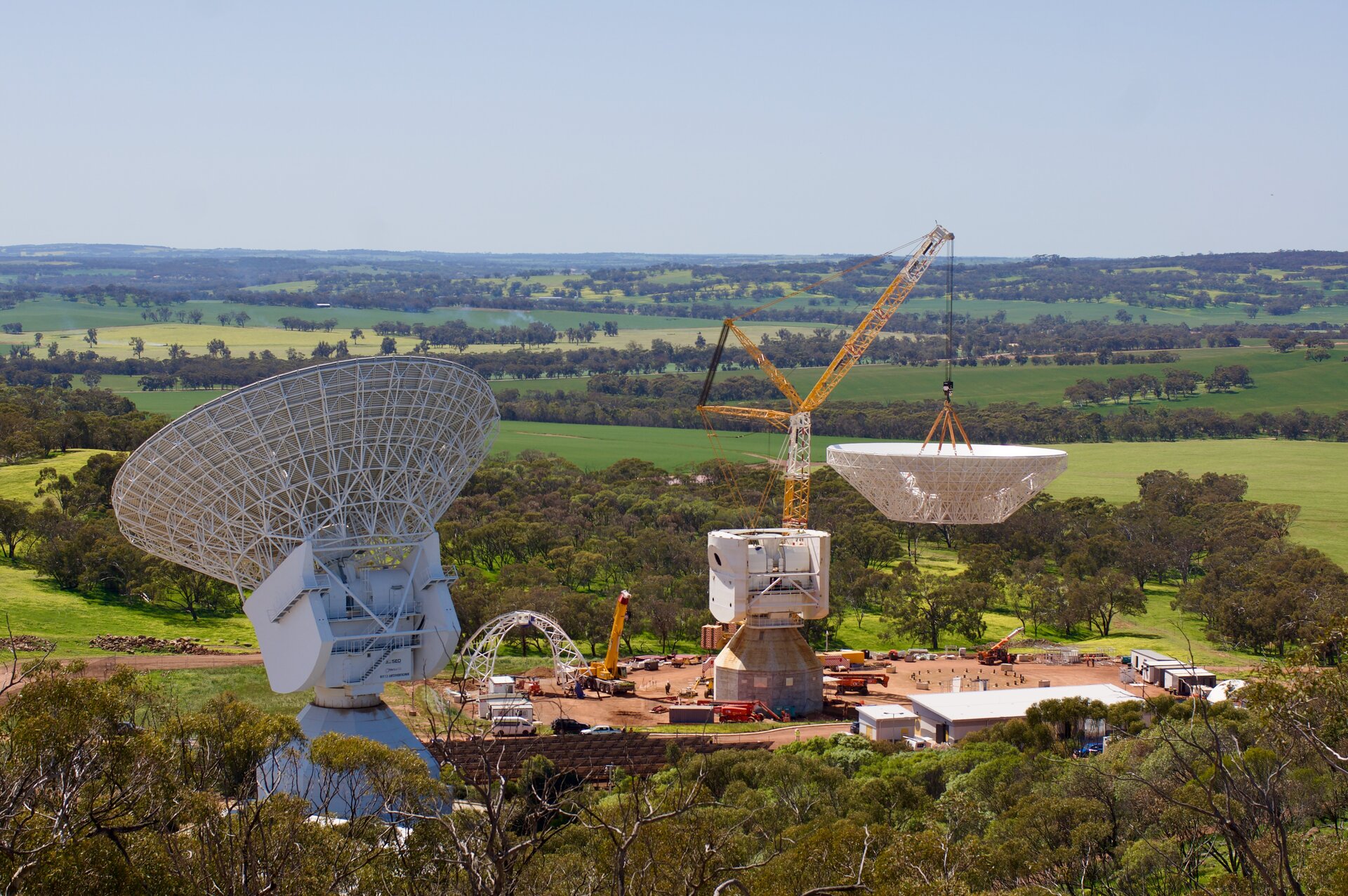02/10/2024
879 views
25 likes
This September saw the completion of a critical milestone for the construction of ESA’s new deep space communication antenna in New Norcia, Australia: the lifting of the 122-tonne reflector dish.
A giant wakes as the Sun sets in Western Australia. The workers can finally rest easy after more than a day spent using an enormous crane to lift the colossal 122-tonne, 35-metre diameter reflector dish and crown ESA’s newest deep space communication antenna.
With the dish and its quadrupole now installed, ESA is on track to inaugurate its fourth deep-space antenna, and second at the New Norcia site in Australia, by the end of 2025. Referred to as NNO3, the New Norcia 3 antenna will allow spacecraft to send and receive more valuable data collected from onboard scientific instruments and vital flight instructions for mission operations.
The construction of the new deep space antenna is a response to the growing capacity needs of ESA’s Programmes. Over the past years, the demand for deep space ground stations has increased significantly as new and more data-intensive missions come to life. Yet the capacity of the three existing deep space antennas in ESA’s global ground station network (Estrack) has nearly reached its limit. The addition of NNO3 to the Estrack network will alleviate operational capacity demands for ESA missions in the coming years, while also providing new capabilities for scientific missions, such as:
- Higher data rates for lunar, astronomical and deep-space missions, thanks to the expansion of the New Norcia site’s downlink portfolio to the K and Ka bands.
- New opportunities for radio science research, thanks to the addition of Ka band uplink capability and dedicated radio science related equipment, as required to support the MORE experiment on the ESA/JAXA BepiColombo mission to Mercury and the 3GM experiment on ESA’s Jupiter Icy Moons Explorer.
- Increased downlink performance, enabled by combining the reception of signals received at the site’s existing deep space antenna, NNO1, and the new NNO3 (known as arraying).
The unique capabilities of this new asset will enable ESA’s Programmes to dream up new types of mission with unprecedented technical requirements.
Set to be launched in 2031 to perform space weather forecasting from the fifth Earth-Sun Lagrange Point, ESA’s Vigil mission, for instance, will require a continuous communication link with Earth, to which NNO3 will contribute.
In addition to primarily serving ESA’s own missions, NNO3 will also be a valuable extension to the wider international collaborative network of deep-space antennas. ESA engages in a number of cross-support agreements with partner space agencies and their deep-space missions and, thanks to its K-band capabilities, NNO3 will play a pivotal role in the science downlink of future partner missions such as NASA’s Nancy Grace Roman Space Telescope.
Next steps
The Ground Stations Engineering team at ESA’s ESOC mission operations centre in Darmstadt, Germany, has decades of expertise building state-of-the-art ground stations across the globe. The construction of the NNO3 antenna is performed under ESA lead through an industrial contract by prime-contractors Thales Alenia Space (France), and Schwartz Hautmont Construcciones Metálicas (Spain). Since the laying of the first stone in June 2022, the antenna tower has been built and the azimuth housing and counterweights assembled. Many underlying infrastructure projects have also been completed.
On 19 September, the antenna’s 122-tonne reflector was lifted and installed on the tower, in an operation requiring millimetre precision. The combination of the 122-tonne load with the turning radius of approximately 20 m – due to the diameter of the main reflector – required the use of a rare 750-tonne mobile crane brought in specially from Perth, 140 km south-west of New Norcia.
“Reaching this critical milestone paves the way for the final stages of the project and further strengthens the team’s determination and motivation,” explains Piermario Besso, NNO3 Project Manager. “We will soon be able to start the deployment of the various subsystems inside the antenna that are required for the commissioning, testing and validation of the complete system and the deployment of a fully operational, state-of-the-art antenna by the end of 2025.”
NNO3 will be the most state-of-the-art of ESA’s deep space antennas, employing a series of novel systems and technologies. It will feature cryo-cooled antenna feeds in X and Ka band, an advanced technology that was recently deployed at ESA’s Cebreros and Malargüe antennas and which allows a significant data capacity increase (40—80% depending on the frequency band). NNO3 is also designed to accommodate future upgrades, particularly a dedicated X-band transmission (80 kW) for emergency use cases, and high data rate uplinks for lunar missions (22.55—23.15 GHz). It will also feature the next-generation Ground station Monitoring and Control – Common Core (GSMC-CC) system.
The NNO3 antenna project includes the extension of the site’s dedicated power plant facility, part of ongoing efforts to reduce ESA’s environmental impact.
In line with ESA’s sustainability goals, a second photovoltaic power generation system with a maximum output of 100 kW is planned for deployment in 2025 and will extend the existing 250 kW photovoltaic plant, which was built in 2017.
Last but not least, the NNO3 project also featured the construction of a new main control room for the three Australian antennas operated by ESA. This facility has already seen operational action: it was from here that the team successfully tracked the debut flight of Europe’s Ariane 6 rocket using the site’s launcher tracking antenna, New Norcia 2, in July 2024.
Australia’s national science agency, CSIRO, has been ESA’s local partner for the operations and maintenance of its first deep space antenna on the site since 2019 and will likewise be responsible for similar activities related to the new antenna.



